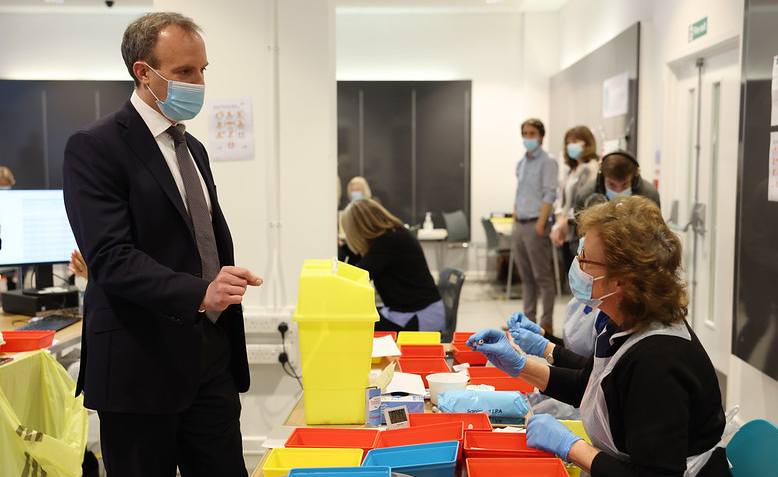 Dominic Raab at a vaccine centre, Photo: Simon Dawson / No 10 Downing Street Flickr / cropped from original / licensed under CC BY-NC-ND 2.0, linked at bottom of article
Dominic Raab at a vaccine centre, Photo: Simon Dawson / No 10 Downing Street Flickr / cropped from original / licensed under CC BY-NC-ND 2.0, linked at bottom of article
Tory spin can create the false impression that vaccination allows us to exit lockdown within a few weeks, writes Alex Snowdon
It was reported yesterday that the R number for coronavirus in the UK has officially fallen below 1. This is the first time it has been firmly below 1 since last July. That is a terrible indictment of the government’s failures.
If R is 1 or higher the virus numbers are growing. What those headlines about this being ‘the first time since July’ are revealing is that we had continuous growth of infections for 6 months prior to the current lockdown.
That is an unforgivably long time. At any point the government could have instituted measures to drive it down. It didn’t. Instead it dithered and delayed, believing that it could ‘manage’ the spread of the virus in such a way that would protect the NHS, while accepting that tens of thousands of people would die.
Legacy of Tory failure
From August onwards the numbers climbed and climbed. This continued until the current lockdown was announced on 4th January. The ‘lockdown in name only’ of November predictably failed to stem the growth. The restrictions endured during the autumn and early winter were in vain, precisely because they were insufficient.
The government waited until we reached a stage of 60,000 confirmed cases a day with an estimated 1 in 50 people infected. It waited until there were 35,000 in hospital and daily death tallies reaching well over a thousand. Only then did it act.
Lockdown is working: the death numbers are falling sharply, week on week. The numbers in hospitals are falling steeply too. This is a direct consequence of the lockdown established 5 weeks ago. We are seeing the fall in infection rates (which began as soon as lockdown was announced) coming through in these figures.
This lockdown could be even more effective if non-essential workplaces were made to close, while providing financial support for affected workers. The TUC – rightly but rather belatedly – took a stand this week in demanding that the number of workers forced into workplaces is reduced.
The death toll, though thankfully falling, remains relatively high because the situation had been allowed to get so catastrophically bad before 4 January. That is why we are still – almost six weeks into lockdown – enduring a high number of losses. It is why hospital numbers, while falling, have still been higher this week than they were in April.
The early prevaricating over lockdown means we now face a longer lockdown too. It is either that or a dangerously stupid premature lifting of restrictions, which is what many Tory backbenchers – and their media cheerleaders – are pushing for.
Vaccines can’t do everything
The vaccine is a game changer. In the long term it is central to dealing with the pandemic.
Vaccine rollout is going very well, with the NHS on the verge of reaching the target of 15 million people receiving their first dose by mid-February. This is largely because it has been coordinated and run properly through the NHS, not outsourced to the private sector.
More immediately, however, the vaccine is not enough on its own. It’s important to recognise that vaccine rollout has so far had little effect on the numbers. It is the lockdown that has brought the numbers down. It is easy for this fact to be obscured amidst the Tory hype which often, mistakenly, gives the impression that there is a causal relationship between the vaccine and the declining infection rates.
We also cannot rely on the vaccine alone because there remain a number of significant unknowns. It isn’t clear how effective it will be against newer strains of the virus. It also isn’t known whether it will reduce infection rates as well as reducing the likelihood of getting seriously ill if infected.
The safest option – and the most sensible approach in the long term – is to wait for infection rates to come down to at most 1000 cases a day before lifting restrictions. It should then be done gradually. This will need to be combined with finally getting ‘test, trace and isolate’ organised properly – it can only be truly effective once numbers are more manageable.
It is vital that we learn the lessons of last year and wait until the infection numbers are well down before a gradual easing of restrictions. This includes waiting until at least 12 April, when the summer term begins, before there is any wider reopening of schools, colleges or universities. Leading epidemiologists have this week warned that premature reopening will drive up the R number in a way that is extremely risky.
The vaccine is a powerful weapon, but it won’t do everything for us. We need a wider strategy geared towards eliminating the virus, not merely managing it.
Before you go
The ongoing genocide in Gaza, Starmer’s austerity and the danger of a resurgent far right demonstrate the urgent need for socialist organisation and ideas. Counterfire has been central to the Palestine revolt and we are committed to building mass, united movements of resistance. Become a member today and join the fightback.

